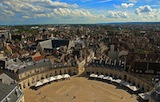l’article du mois – mars 2019
 How relevant are local climate zones and urban climate zones for urban climate research? Dijon (France) as a case study
How relevant are local climate zones and urban climate zones for urban climate research? Dijon (France) as a case study
Yves Richard, Justin Emery, Julita Dudekc, Julien Pergaud, Carmela Chateau-Smithd, Sébastien Zito, Mario Rega, Thibaut Vairet, Thierry Castel, Thomas Thévenin, Benjamin Pohl
2018 Urban Climate 26258–274
Several typologies of urban surface properties have been proposed, in recent years, for urban heat island studies and climate modeling. Some were specifically developed for cities and urban climate issues, like the Urban Climate Zones, and the more recent Local Climate Zones. The initialobjective of this paper is to evaluate the capacity of these two typologies to identify thermal environments in and around cities, and to determine which typology best captures the daily spatio-temporal patterns of surface and urban canopy heat islands.
To simulate urban climate with a model, LULC data based on a given typology are required. To avoid circularity, we combined the Corine Land Cover database, with data for the whole of Europe, and the BD TOPO database, for France, to form a new tool, CLC_USGS, which we used as input for the WRF limitedarea model, with a 150-m grid resolution. The capacity of each typology to identify coherent thermal zones was estimated for Dijon, a medium-sized French city, during a three-week heat wave, over a 24-hour period, in conditions favorable to urban heat island development. The comparison was based on hourly air temperatures directly output from the WRF model, those obtained from the purpose-built MUSTARDijon 47-sensor meteorological network, and NDVI values and land surface temperatures estimated from Landsat images for 11 July 2015 at 1030 UTC. Typical diurnal variations and spatial contrasts of surface and air temperatures were identified in both simulations and observations. As both typologies show significant capacity for identifying thermally coherent intra-urban areas, this study suggests that they could both be useful for urban climate applications. The typology that is most generally applicable in worldwide contexts is Local Climate Zones.
- kc_data:
- a:8:{i:0;s:0:"";s:4:"mode";s:0:"";s:3:"css";s:0:"";s:9:"max_width";s:0:"";s:7:"classes";s:0:"";s:9:"thumbnail";s:0:"";s:9:"collapsed";s:0:"";s:9:"optimized";s:0:"";}
- kc_raw_content:
 How relevant are local climate zones and urban climate zones for urban climate research? Dijon (France) as a case study
How relevant are local climate zones and urban climate zones for urban climate research? Dijon (France) as a case studyYves Richard, Justin Emery, Julita Dudekc, Julien Pergaud, Carmela Chateau-Smithd, Sébastien Zito, Mario Rega, Thibaut Vairet, Thierry Castel, Thomas Thévenin, Benjamin Pohl
2018 Urban Climate 26258–274
Several typologies of urban surface properties have been proposed, in recent years, for urban heat island studies and climate modeling. Some were specifically developed for cities and urban climate issues, like the Urban Climate Zones, and the more recent Local Climate Zones. The initialobjective of this paper is to evaluate the capacity of these two typologies to identify thermal environments in and around cities, and to determine which typology best captures the daily spatio-temporal patterns of surface and urban canopy heat islands.
To simulate urban climate with a model, LULC data based on a given typology are required. To avoid circularity, we combined the Corine Land Cover database, with data for the whole of Europe, and the BD TOPO database, for France, to form a new tool, CLC_USGS, which we used as input for the WRF limitedarea model, with a 150-m grid resolution. The capacity of each typology to identify coherent thermal zones was estimated for Dijon, a medium-sized French city, during a three-week heat wave, over a 24-hour period, in conditions favorable to urban heat island development. The comparison was based on hourly air temperatures directly output from the WRF model, those obtained from the purpose-built MUSTARDijon 47-sensor meteorological network, and NDVI values and land surface temperatures estimated from Landsat images for 11 July 2015 at 1030 UTC. Typical diurnal variations and spatial contrasts of surface and air temperatures were identified in both simulations and observations. As both typologies show significant capacity for identifying thermally coherent intra-urban areas, this study suggests that they could both be useful for urban climate applications. The typology that is most generally applicable in worldwide contexts is Local Climate Zones.
- extrait:
- lien_externe:
